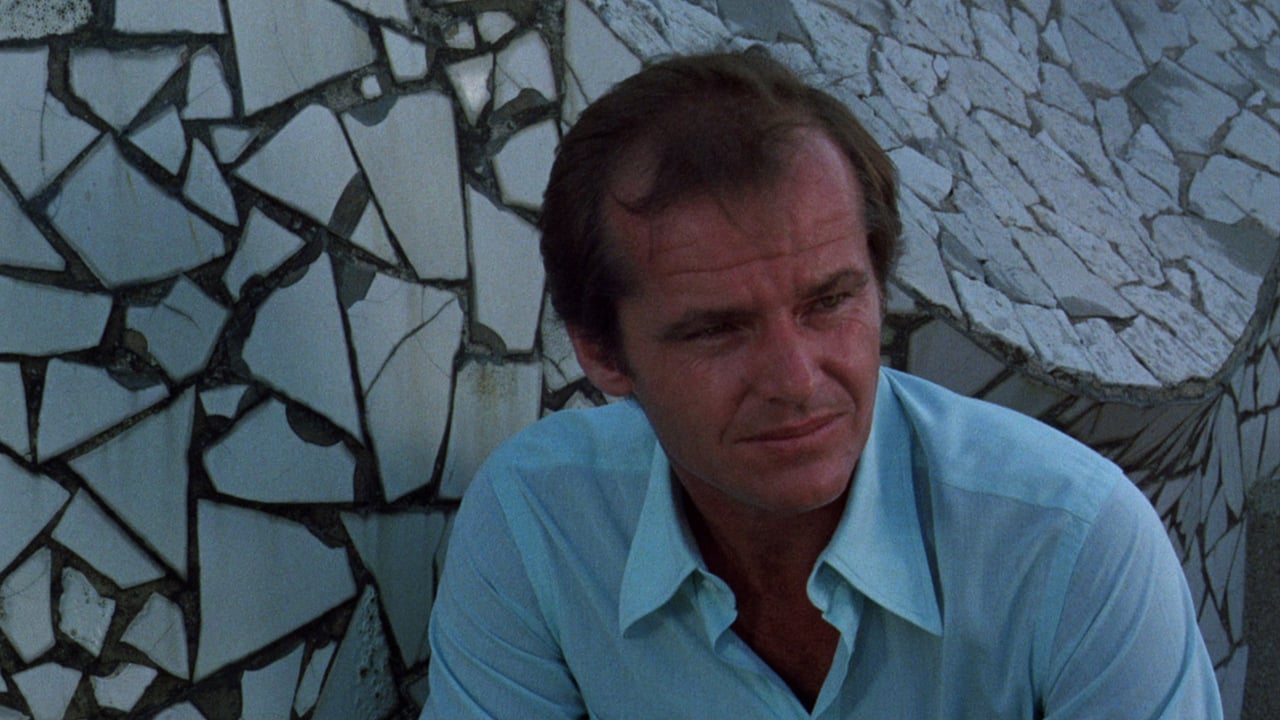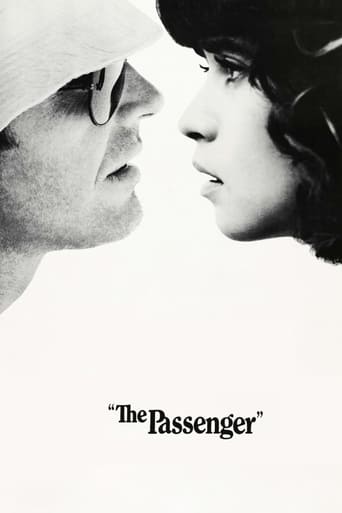



I like the storyline of this show,it attract me so much
View MoreThe film may be flawed, but its message is not.
This is one of the best movies I’ve seen in a very long time. You have to go and see this on the big screen.
View MoreWorth seeing just to witness how winsome it is.
When the protagonist tried to cover himself with someone else's identity, he just entered another cage. Rarely, Michelangelo Antonioni began to explain the theme in his own film, of course, the best part of the film is still his ingenious scene scheduling and lens movement. "Even if you try to escape, you can't keep going." Antonioni's desperation is probably deep in his mind. In addition, Jack Nicholson contributed a precious performance in this film beyond his comfort zone.
View MoreI saw Antonioni's "The Passenger" in September or October 1976, at the beginning of my freshman year at Columbia. It was the first "art house film" I ever saw, well before I'd heard that term. I was from Cincinnati, where apparently they didn't have such things. I had just turned 19, or was about to. I was taking a writing class with Kenneth Koch, discovering Frank O'Hara and Rimbaud, and doing everything I could to peel or dissolve the suburban Midwestern scales from my eyes. In that pursuit, this movie was as important as the LSD I would drop for the first time a few weeks later. Not that it was hallucinatory—just the opposite, in fact though in both cases, perhaps, it was "the visuals" that I liked best.The film was playing at an auditorium on the Barnard campus, and I remember walking over there alone, being completely amazed by what I saw, and hurrying back to my Spartan dorm room to write excitedly about it in a notebook that is now long gone. I don't remember what I wrote, but I know it wasn't focused on Jack Nicholson, who plays a television reporter disillusioned with his life and work. Nor did I write much about the plot involving switched identities, riveting though it was. If I wrote about these things at all, it would have had to do with the way Antonioni de-emphasized Nicholson's movie star status and took the weight off a plot that would have been handled ponderously in a Hollywood movie, accompanied by ridiculous, tension-building background music. (I'd seen "Jaws" just the year before, which suddenly felt like ages ago.)In fact, everything in "The Passenger" had a different emphasis than it did in the movies I had grown up seeing; everything about it felt refreshingly "un-American." Nothing was explained: I was as clueless about what was going on as Nicholson's character and, like him, had to figure things out as I went along—discovering, with him, that he'd taken on the life of a gunrunner in Africa (like Rimbaud!). The film's pacing was slow, giving me time to think and, especially, to look. I was astonished by the long stretches of silence during which no one spoke at all. The minimalist approach made the movie feel not smaller but more expansive, making room for something else, which filled me with a calm excitement: beauty. I remember being struck, in the early scene in which Nicholson's character breaks down, by the gorgeous shots of the salmon-colored dunes against the blue sky in the saturated light of the African desert—then, in the scene where Nicholson's character changes identities with the dead man in the room across the hall, by the turquoise walls of the hotel hallway he drags the body through, and by the contrasting yellow doors. If you haven't seen the movie, this must sound crazy, but these, I think, are the things I wrote about in my notebook. And I'm sure I wrote about the shot of Nicholson from above, leaning out the window of an aerial tram and slowly flapping his arms like wings above the shimmering blue water of Barcelona's harbor. And the shot of Maria Schneider kneeling backwards in the red leather back seat of a convertible, spreading her arms and smiling as the plane trees lining both sides of a country road flicker by, seemingly without end. And the long, penultimate shot in which the camera (instead of focusing on the murder taking place) seems to move right through the bars of a hotel room window out into a dusty town square like something from a de Chirico painting.Of course, this would have all been written with the exuberance of my nineteen-year-old self, and I'm sure that notebook entry, if I read it now, would induce both nostalgia and embarrassment. I wasn't inclined to interpret these images so much as bask in the way they opened me up to another way of seeing. When I watch the movie now, in middle age, I notice many other things, among them the theme of not being able to escape oneself. But one of the things I'm glad I can't escape, or at least forget, is the intensity of my first encounter.First published in "New Ohio Review," copyright Jeffrey Harrison.
View MoreThis is one excellent film. The modern day Jack Nicholson has become such a caricature that we forget some of his best work was done as a young man. I've never heard how he hooked up with Anonioni. The film is both lush and stark. The desert scenes are so cold and depressing. Nicholson's character comes back to the hotel after a battle with Saharan sand and finds another "reporter" dead. Coincidentally they are very close in appearance and Nicholson, who is full of angst and ennui, decides to trade places with the dead man, taking on his identity. Going rogue, he finds himself in league with some really bad people. With the help of Maria Schneider ("Last Tango in Paris"), he manages to stay ahead of both his wife (who thought he was dead) and those who would do him harm. At least for a while. The cinematography is quite astounding here. The movie makes one uncomfortable, because there is the tension that occurs when possible identification is around every corner. To me, this is quite an amazing product of one of Italy's most creative directors.
View MoreAlthough I had seen Michelangelo Antonioni's "The Passenger" when it first appeared on television in the late 70's, I was disappointed that it didn't seem to measure up to "Blowup", and pretty much forgot about it.However, there have been so many references to the film over the years, especially when the conversation turns to movies with ambiguous plots and obscure endings, that I decided to give it another go.I still don't think it has the sharpness or style of "Blowup", but I now appreciate it more, and definitely love that unresolved ending. However, it has a flaw, and it weakens the film – it's a mistake that Hitchcock would never have made.Jack Nicolson plays David Locke, a reporter seeking to interview rebel leaders in North Africa. He is disillusioned with just about everything, before suddenly seeing a chance at a new life. When David Robertson (Charles Mulvehill), a man who looks uncannily like him, dies of a heart attack in the same hotel, Locke swaps identities with him.Although he gets away with it, he begins to realise that Robertson is an illegal arms dealer, and is involved with dangerous people. As he travels from Africa to London and then on to Spain, the movie becomes a waiting game to see which of Jack's pasts will catch up with him first.And what do I think is the flaw in the film? It's all in the timing. More than half way through the movie, Locke meets Maria Schneider's character, billed simply as 'Girl'. Schneider brings such an aura of sexual tension to the film that you realise just how flat the first half has been. Antonioni should have brought her in far earlier.What an amazing impact she has, whether it's memories of her character from "Last Tango in Paris" or simply her enigmatic sultriness, she gives the film a charge of energy. The best scenes in "The Passenger" come from the air of expectation built up around Jack Nicholson's double identities and the presence of Maria Schneider.The movie was made in 1975 and, as was the vogue in many European and Hollywood movies at the time, romanticises the revolutionaries and guerrillas. However, divorced from the headlines and the mood of the 70's, the back-story of "The Passenger" seems overly contrived.For anyone who has not seen the "The Passenger", but been exposed to all the tricky plots in films over the intervening years, you could be forgiven for wondering what all the fuss was about. The film generated a great deal of analysis about the idea of escaping one's identity, but surely more has been read into it than could ever have been intended.Nonetheless, "The Passenger" still has the unique pairing of Nicholson and Schneider, and that deliciously ambiguous ending.
View More